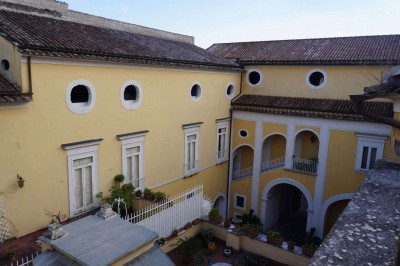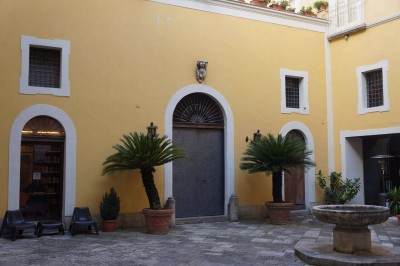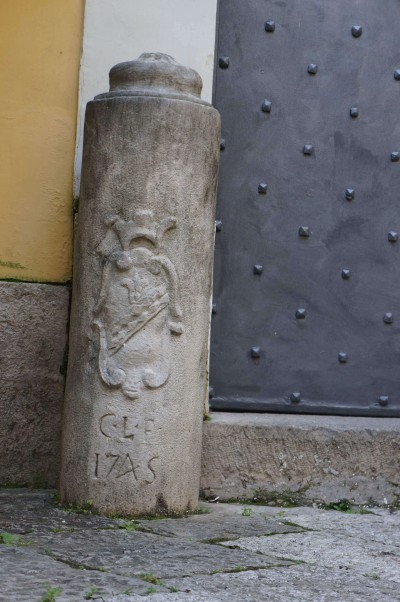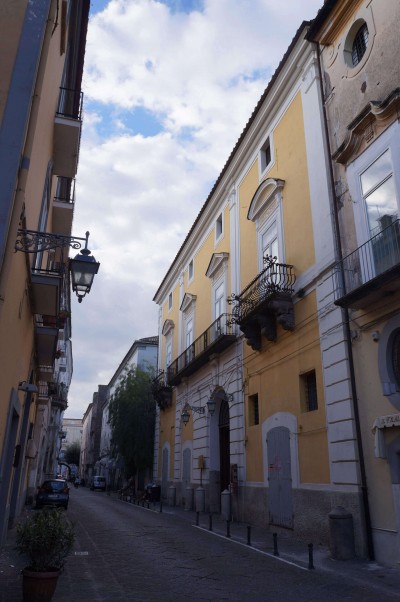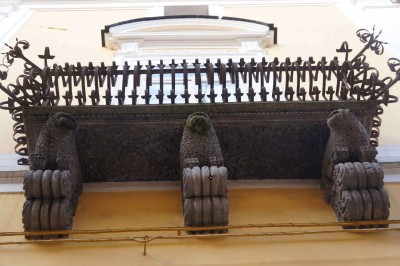Palazzo Lanza has been the home of the Lanza family since 1453 and is located in the heart of the historical centre
Contact the abode
Since 1453, Palazzo Lanza has been the home of the Lanza family, a patrician dynasty of Capua dating back to the 15th century. From that time forwards, it has been subject to a tradition of passing down the property to the eldest male heir, which to this day still continues with the sixteenth successive generation.
A notarial deed from those years, found in the house's archives, testifies that the family were already resident in the house at that time: '... in parti domorum... sitarum Capue, in parrocchia ecclesie Sancti Rufi in Capua, iuxta viam publicam...' (‘... in parts of houses... situated in Capua, in the parish of the Church of San Rufus in Capua, near the main road...’).
The building is located in the heart of the historical centre of Capua, just a few steps away from the ancient Grand Priory of the Order of Malta.
The construction of the Baroque balconies on the façade, supported by gargoyles, was documented in 1697, and in 1731 the private oratory in the house was founded, as granted by Pope Benedict XIII. Among other artifacts, it houses the relic of Saint Alphonsus Maria de' Liguoro, who the family hosted as one of their own.
In 1745, Baron Carlo Lanza erected the rear part of the house, with its terrace overlooking the courtyard, and in 1807, the façade was restored in a sober Neoclassical style according to a design by engineer Luigi Jannotta, retaining the Baroque balconies. Inside the residence, some of the rooms were decorated with tempera paintings in the grotesque style.
The house preserves the drape on which the Treaty of Casalanza which dethroned Joachim Murat was signed on 20 May, 1815, returning the throne of Naples to Ferdinand of Bourbon. The Palazzo was occupied by French soldiers in 1799 and again in 1806, when General Berthier lodged there. The former stables now house a restaurant and a library, while a section of the attic area is used for accommodation.
THE HISTORY OF PALAZZO LANZA
The family archive is stored in a room on the main ‘piano nobile’ floor and contains documents dating from the 15th to the 19th century about the Lanza family (known as the de Buzzettis until the 15th century, which was the name of one of their ancient fiefdoms). It is bound by the Archival Superintendency for Campania due of its importance and includes about fifty notarial documents and deeds relating to family successions, sales and donations dating from 1462 to 1691.
One of the most notable of these is the act of donation showing that the founder of the family, Agnesella, gave the fief of Casanova near Caserta to her three sons Carlo, Joanne and Pirro. The house that still conserves these archives today is mentioned for the first time in this deed. It also contains a bundle of autographed letters written between 1554 and 1556 by Bona Sforza, Queen of Poland, to Pompeo Lanza, her diplomat at the court of Charles V in Brussels and later at the court of Mary Tudor in London. During this period, the family were close friends and constant companions of the Habsburg emperor.
The archive also includes: several manuscript tomes with parchment covers relating to various topics between the 16th and the 19th centuries; a handwritten report from 1646 on the origins of the family, detailing its genealogical tree; vice-royal privileges and Neapolitan citizenship patents with tax exemptions from the 17th and 18th centuries granted to various members of the family; papal bulls from the 18th century appointing various religious members of the House to ecclesiastical positions; a bull of investiture from the 18th century appointing a family member as a knight of the Sovereign Military Order of Malta; episcopal briefs from the 18th century confirming the concession of the private oratory in the house; some of the family's 18th-century feudal head-letters and one of the memoirs written in 1806 by Don Biase Lanza, who lived at the turn of the 18th and 19th centuries and is credited with having organised the archive so efficiently that the same method has been retained to this day.
FACILITIES AND SERVICES: STAYING AT A HISTORICAL RESIDENCE IN CAPUA
It is possible to stay at the Palazzo’s elegant and comfortable rooms. Prices are available upon request.
